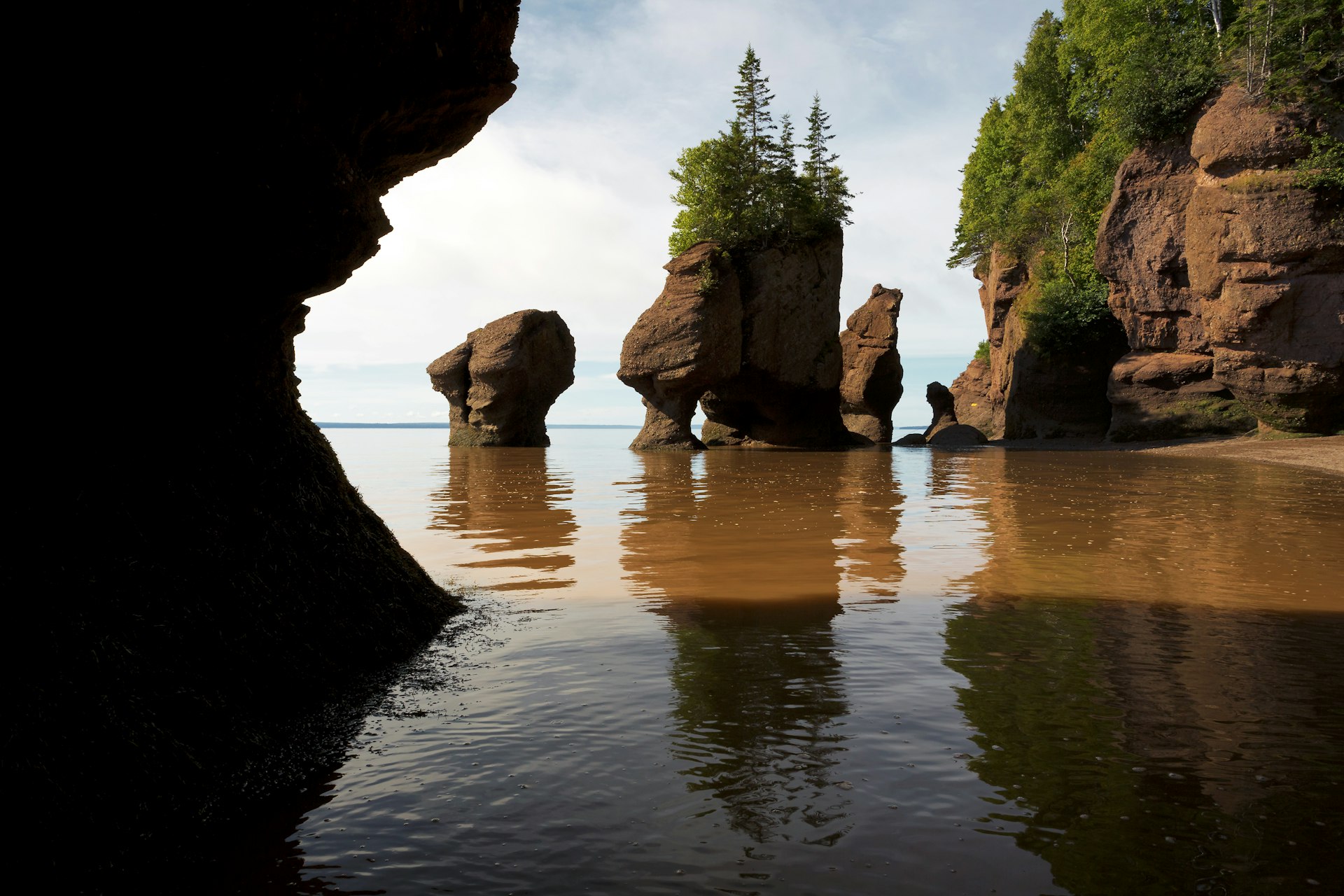Made up of majestic mountain peaks, sprawling prairie lands, wild boreal forests, arctic tundras, and the longest coastline in the world, Canada’s natural wonders make the world’s second-largest country a top destination for outdoor adventure.
Canada is comprised of 20 designated Unesco World Heritage Sites and 48 protected national parks, all with protocols in place to ensure that some of the country’s most magnificent natural wonders are preserved and the wildlife and ecosystems remain protected.
From Canada’s answer to the Swiss Alps to The Amazon of the North, these are the 12 best natural wonders found around Canada.

1. The Canadian Rockies, British Columbia and Alberta
Best for mountain scenery
The saw-tooth, white-topped mountains straddling the British Columbia–Alberta border inspire both awe and action. Four national parks can be found in this region: Banff – Canada’s oldest and most-visited national park, Jasper, Yoho, and Kootenay – all offering countless opportunities to delve into the lush wilderness, with ribbons of hiking trails, rushing white water and powdery ski slopes that are often referred to as the Swiss Alps of Canada.
The Rockies Rail Route provides another popular way to experience the grandeur: luminous lakes, jumbles of wildflowers and glistening glaciers glide by as the steel cars chug up mountain passes and down river valleys en route to points east or west.
2. Haida Gwaii, British Columbia
Best remote islands
Experience the rugged and remote wilderness of British Columbia with a visit to Haida Gwaii, a cluster of islands found 100km (62 miles) west off the northern coast of British Columbia. Once known as the Queen Charlotte Islands, this dagger-shaped archipelago is best experienced through Indigenous tours and operators, a great way to get immersed in the unique culture and landscape of the area.
Colossal spruce and cedars cloak the wild, rain-sodden landscape. Bald eagles and bears roam the ancient forest, and sea lions and orcas cruise the waters.
But the islands’ real soul is the resurgent Haida people, best known for their war-canoe and totem-pole carvings. See the lot at Gwaii Haanas National Park Reserve, which combines lost villages, burial caves and hot springs with some of the continent’s best kayaking.

3. The northern lights
Best nighttime wonder
Most of Canada’s northern region is found beneath the Northern Hemisphere’s Aurora Oval, creating several hot spots for night-sky activity. High-latitude places, from the Labrador coast to arctic villages, may not seem like much during the day, but at night, drapes of green, yellow, aqua, violet and other polychromatic hues flicker and dance across the sky.
The natural phenomenon can be seen during all four seasons, depending on which province you visit. During the summer months (July to September), head to Torngat National Park found on the Labrador Penninsula, where a guided tour will connect you with Inuit Elders to learn about the dramatic geology, human history, and traditional practices found in this unique region.
February and March are high-season aurora months in Churchill, Manitoba. Experienced tour operator Frontiers North will suit you up in the proper winter attire and then take you to the best viewing spots in a heated tundra buggy.

4. Niagara Falls, Ontario
Best iconic wonder
The world’s second-largest waterfall by volume and Canada’s most famous natural attraction, Niagara Falls is a stunning site located in a city of the same name found in Ontario and linked to the US by several bridges and a trio of falls – The American Falls and Bridal Veil Falls (on the US side), and Horseshoe Falls (the Canadian falls, and the largest of the three).
Niagara Falls may make a big splash, but the falls are short – they don’t even crack the top 500 worldwide for height.
But when those great muscular bands of water arc over the precipice like liquid glass, roaring into the void below, and when you sail toward them in a mist-shrouded boat, Niagara Falls impresses big time.
In terms of sheer volume, nowhere in North America beats its thundering cascade, with more than one million bathtubs of water plummeting over the edge every second.
5. Baffin Island, Nunavut
Best Ice Age landscapes
Baffin Island has a human history that dates back 3000 years, and to this day, Inuit people still call the land home, making up 70% of the area’s population.
Believed to be the birthplace of the last Ice Age due to its landscape, Baffin Island is part of the Canadian Arctic Archipelago, a cluster of Canadian islands that nearly reach the center of the Arctic Circle.
It’s Canada’s largest island and the fifth largest island in the world, home to cloud-scraping mountains and a third of Nunavut’s population.
The island’s crown jewel is Auyuittuq National Park – or “the land that never melts” – and indeed deep fjords, glacial valleys, and vertiginous cliffs fill the eastern expanse. The park is a siren call for hardcore hikers and climbers, and more than a few polar bears.

6. Nahanni National Park Reserve, Northwest Territories
Best for river experiences
Gorgeous hot springs, haunted gorges and gorging grizzlies fill this remote park near the Yukon border, and you’ll have to fly in to reach them. Only about 1000 visitors per year make the trek, half of them paddlers trying to conquer the South Nahanni River.
Untamed and spectacular, it churns along 500km (310 miles) through the Mackenzie Mountains. Thirty-story waterfalls, towering canyons and legends of giants and lost gold round out the journey north. Visit on a fly-in day trip or paddle the Mackenzie River for a week or two.
7. Moraine Lake, Alberta
Best remote lake
The spectacular, deep teal water of Moraine Lake is one of Banff’s most iconic sights. The lake’s rugged and remote setting in the Valley of the Ten Peaks, accessed by a narrow winding road, only adds to its allure. Sitting snug between mountains, waterfalls, and rock piles, the scene surrounding the lake is so stunning that it seems surreal.
Many visitors prefer Moraine Lake to the more famous Lake Louise – so many, in fact, that you’ll have to be lucky or an early riser to get a parking spot here; the lot often fills up by 5:30am during peak season.
8. Tablelands, Newfoundland
Best rocky landscapes
Located in Gros Morne National Park, found on the west coast of the island of Newfoundland, Tablelands is a site of geological significance. A result of 400 million years of mountain erosion, the exposed core of the Earth can be seen in what looks like a rocky orange landscape.
Its rock is so unusual that plants can’t even grow on it. You can view the barren golden phenomenon up close on Rte 431, or catch it from a distance at the stunning photography lookout above Norris Point.

9. Hopewell Rocks, New Brunswick
Best for unusual coastal scenery
A nature-sculpted masterpiece found in the Bay of Fundy, The Hopewell Rocks are bizarre sandstone erosion formations, also known as “flowerpots,” rising from the ocean floor. They resemble giant arches, stone mushrooms and animals.
Many come to marvel at their Dr. Seussian look, making the rocks New Brunswick’s top attraction and certainly one of its most crowded.
You can only walk amid the rocks at low tide; at high tide, the rock towers are still visible from the well-trafficked trails that wind through the woods above, or you can join a kayaking tour to bob around them from the water.
10. Torngat Mountains National Park, Newfoundland / Labrador
Best for beautiful landscapes
An Inuit homeland and the northernmost tip of continental Canada, the Torngat Mountains National Park can only be accessed by boat, charter plane, or helicopter, and a landing permit must be obtained in order to access the site.
Some of Earth’s oldest rocks can be found here, and polar bears and caribou can be spotted roaming freely. Ancient footsteps, powerful stories and Inuit traditions pair with dramatic landscapes and wildlife encounters that offer the perfect balance of nature and culture.

11. The Prairies, Saskatchewan / Manitoba
Best for big skies and solitude
Solitude reigns in Canada’s middle ground. Driving through the flatlands of Manitoba and Saskatchewan turns up uninterrupted fields of golden wheat that stretch to the horizon, eventually melting into the sunshine.
When the wind blows, the wheat sways like waves on the ocean, punctuated by the occasional grain elevator rising up like a tall ship. Big skies mean big storms that drop like an anvil, visible on the skyline for miles.
12. Manitoulin Island, Ontario
Best shimmering views
The largest freshwater island in the world and Ontario’s best-kept secret, Manitoulin Island floats right in Lake Huron’s midst, a slowpoke place of beaches and summery cottages. Jagged expanses of white quartzite and granite outcroppings edge the shoreline and lead to shimmering vistas.
First Nations culture pervades, and the island’s eight communities collaborate to offer local foods (wild rice, corn soup) and eco-adventures (canoeing, horseback riding, hiking), as well as powerful powwows that add drumming, dancing and storytelling to the culturally-immersive activities offered.










